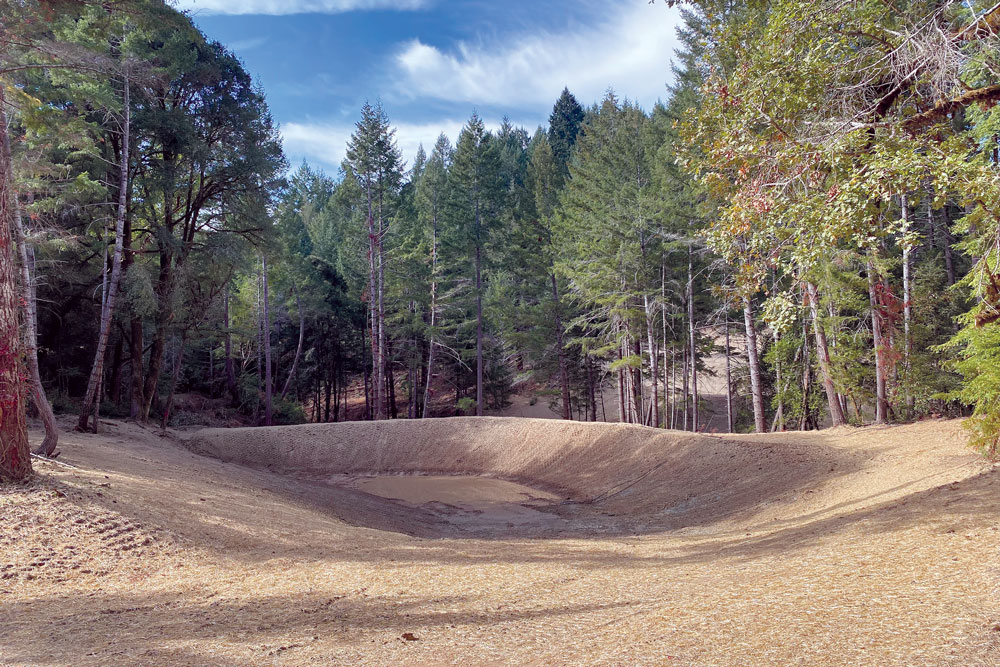Streamflow and Habitat Enhancement in North Fork Lost River

By Ash Brookens, Sanctuary Forest
In the fall of 2021, Sanctuary Forest was awarded $2 million in funding by the Wildlife Conservation Board to implement a multifaceted project on the North Fork of Lost River, a Class I tributary to the Mattole River, with the goal of improving conditions for native coho and their supporting species within the headwaters ecosystem. Through continued monitoring of our previous stream-enhancement projects throughout recent drought years, we’ve garnered keen insights about what’s working well and where a “stacking” approach is needed to restore ecological processes (see our previous Forest & River News article Stacking Restoration Strategies, Summer 2022).
Terrace Ponds
In order to address urgent low-flow conditions within the Mattole River watershed, we’re integrating strategies in the North Fork Lost River Flow-Enhancement Project that will be familiar to many who’ve been following our work in McKee Creek and elsewhere in the headwaters: instream channel-spanning structures with subsurface clay restrictive layers and strategic grading that reconnects incised channels to adjacent floodplains. We’re utilizing a new strategy in constructing terrace ponds. Though guided by lessons learned in constructing the String of Pearls ponds in nearby Baker Creek, these terrace ponds in the North Fork Lost River differ in that they aren’t designed for groundwater recharge so much as to store surface water for direct augmentation of streamflow. Instead of building them to catch, hold, and slowly release water to the adjacent stream, they’re designed to hold water until late summer, when stored water will be delivered directly to the stream by pipe-and-valve infrastructure. As Tasha McKee explains, “This adaptation is necessary because flow benefits from the slow-release method only lasted until early August, and did not solve the problem of low flows with disconnected pools and trapped salmonids.” The North Fork Lost River will be the first location where Sanctuary Forest utilizes this “metered-flow” strategy.
This exciting work in the North Fork began mid-summer and is currently underway, with several of our region’s most skilled implementation subcontractors—McCullough Construction, Mattole Salmon Group (MSG), Edwards Excavation, and Stillwater Sciences—working concurrently with Sanctuary Forest to mitigate the impacts of legacy logging while creating new opportunities for water storage and flow augmentation. In September, McCullough Construction completed the shaping of a northern and southern terrace pond, which have the capacity to store 750,000 and 450,000 gallons, respectively. Like the Baker Creek ponds, these are not plastic-lined but rather sealed by a bentonite keyway that prevents water from flowing under and/or through the berm. The upslope sides of the pond are not sealed, which allows for storage and seepage of cool groundwater back into the pond as water levels drop. This helps keep water temperatures low, particularly in the deepest area of the ponds from where streamflow augmentation water will be drawn. As of this writing, Sanctuary Forest and Mattole Restoration Council staff are preparing to seed the pond sites with native vegetation.
Re-grading and Installing Large Woody Structures
McCullough Construction also worked alongside the Mattole Salmon Group on installation of valley- and channel-spanning log weirs that incorporate subsurface weirs and clay barriers. As described in the project’s Basis of Design Report (Stillwater Sciences, May 2022): “While grade control structures (log and boulder weirs) typically are tied into the [streambed] and banks to reduce undercutting and flanking during high-flow events, the intent of the restrictive barrier is to go a step farther and reduce underflow and flanking by groundwater.” The “modified Stage-0” restoration technique readers may recall from our previous article has been implemented; and farther downstream, Mattole Salmon Group has reshaped the streambed, connecting it with its historic floodplain. In both places, this re-grading reverses the deep channel incision characteristic of streams lacking large and plentiful wood in their channels. Both McCullough and MSG are installing additional large wood structures throughout the project reach. By this autumn’s rainfall, about half of these structures will be in place, set to store winter water in the stream banks and create complex habitat for fish.
Moving Forward, with Gratitude for a Talented Team of Restoration Implementers!
Even as new strategies are being put into action in order to hold more water, upgrades to existing infrastructure are underway. Culverts are scheduled for replacement to improve fish passage; and an existing road (which was too close to the stream) has been removed, with improvements made to enable use of an alternate access road. There’s much more on the slate for next implementation season, but the transformation thus far in the North Fork of Lost River has been impressive. We’ll be monitoring this project as the rains fall and processes unfold—and planning for a new phase of restoration work using these techniques in the South Fork of Lost River. We’ll keep our community updated!
Responding to the challenges created by extractive or imbalanced land-use paradigms requires integration of multiple strategies, but it also calls for the creative vision, experience, and skill of a diverse and dedicated group of people. Sanctuary Forest holds great appreciation for our funders, Wildlife Conservation Board and the Department of Water Resources, our community supporters, and our implementation partners: Stillwater Sciences, McCullough Construction, Mattole Salmon Group, Mattole Restoration Council, and Edwards Excavation. Thank you for continuing to prioritize this unique and irreplaceable watershed.
For more information: sanctuaryforest.org
